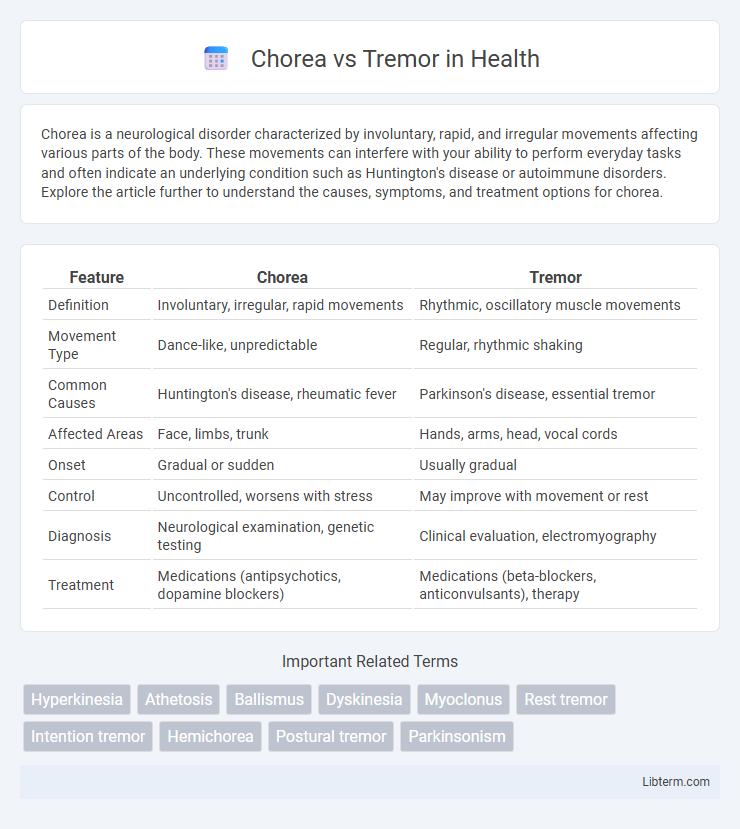Chorea is a neurological disorder characterized by involuntary, rapid, and irregular movements affecting various parts of the body. These movements can interfere with your ability to perform everyday tasks and often indicate an underlying condition such as Huntington's disease or autoimmune disorders. Explore the article further to understand the causes, symptoms, and treatment options for chorea.
Table of Comparison
| Feature | Chorea | Tremor |
|---|---|---|
| Definition | Involuntary, irregular, rapid movements | Rhythmic, oscillatory muscle movements |
| Movement Type | Dance-like, unpredictable | Regular, rhythmic shaking |
| Common Causes | Huntington's disease, rheumatic fever | Parkinson's disease, essential tremor |
| Affected Areas | Face, limbs, trunk | Hands, arms, head, vocal cords |
| Onset | Gradual or sudden | Usually gradual |
| Control | Uncontrolled, worsens with stress | May improve with movement or rest |
| Diagnosis | Neurological examination, genetic testing | Clinical evaluation, electromyography |
| Treatment | Medications (antipsychotics, dopamine blockers) | Medications (beta-blockers, anticonvulsants), therapy |
Introduction to Chorea and Tremor
Chorea is characterized by involuntary, irregular, and rapid movements that flow unpredictably across different muscle groups, often associated with neurological disorders like Huntington's disease. Tremor involves rhythmic, oscillatory movements caused by alternating muscle contractions, commonly seen in conditions such as Parkinson's disease and essential tremor. Both movement disorders result from distinct pathophysiological mechanisms affecting the basal ganglia and motor control pathways.
Defining Chorea: Key Features
Chorea is characterized by sudden, involuntary, irregular, and jerky movements that flow unpredictably across different body parts, contrasting with the rhythmic and oscillatory nature of tremors. Key features of chorea include rapid, non-repetitive motions that often appear dance-like and can affect the face, limbs, and trunk. Unlike tremors, which typically involve steady shaking during movement or rest, chorea's unpredictable muscle contractions result from basal ganglia dysfunction, often seen in conditions like Huntington's disease.
Defining Tremor: Key Characteristics
Tremor is defined as an involuntary, rhythmic, oscillatory movement of a body part, typically affecting the hands, arms, head, or voice. Unlike chorea, which involves irregular, rapid, and unpredictable jerky movements, tremors have a consistent frequency and amplitude, often worsening during voluntary movements or at rest depending on the tremor type. Essential tremor and Parkinsonian tremor are common clinical examples distinguished by their specific patterns and underlying neurological mechanisms.
Underlying Causes of Chorea
Chorea is primarily caused by neurodegenerative disorders such as Huntington's disease, autoimmune conditions like Sydenham's chorea, metabolic imbalances including hyperthyroidism, and certain medications or toxins. Unlike tremors, which often result from Parkinson's disease or essential tremor origins, chorea arises from dysfunction in the basal ganglia circuitry, especially involving the striatum. Genetic mutations, infectious diseases, and vascular lesions also contribute to the underlying causes of chorea.
Underlying Causes of Tremor
Tremor primarily results from neurological disorders affecting the basal ganglia, cerebellum, or peripheral nerves, with common causes including Parkinson's disease, essential tremor, and multiple sclerosis. Metabolic conditions such as hyperthyroidism and side effects of medications like lithium can also induce tremors. Unlike chorea, which often arises from genetic or autoimmune origins, tremor's underlying causes are frequently linked to neurodegenerative diseases and systemic disturbances.
Clinical Presentation: Chorea vs Tremor
Chorea is characterized by involuntary, irregular, and unpredictable muscle movements that often flow from one body part to another, resulting in a dance-like appearance. Tremor presents as rhythmic, oscillatory movements typically affecting the hands, head, or voice, and can be classified into rest, action, or intention tremors based on when they occur. Clinically, chorea disrupts voluntary motor control with sudden, jerky motions, while tremor consistently involves repetitive shaking that may worsen with movement or posture maintenance.
Diagnostic Approaches and Differentiation
Chorea and tremor can be differentiated through clinical assessment and diagnostic tools such as electromyography (EMG) and video analysis of movement patterns. Chorea features irregular, rapid, involuntary movements with variable amplitude, often affecting distal limbs, while tremor manifests as rhythmic, oscillatory muscle contractions detectable at rest or during action. Neuroimaging and genetic testing contribute to identifying underlying causes, supporting the diagnostic distinction between chorea, commonly linked to Huntington's disease, and tremor, frequently associated with Parkinson's disease or essential tremor.
Common Disorders Associated with Chorea and Tremor
Chorea is commonly associated with disorders like Huntington's disease, Sydenham's chorea, and lupus, reflecting its characteristic involuntary, rapid, irregular movements. Tremor frequently presents in conditions such as Parkinson's disease, essential tremor, and multiple sclerosis, marked by rhythmic shaking usually involving the hands. Both movement disorders highlight distinct neurological pathways and are critical in the clinical diagnosis of underlying systemic or neurodegenerative diseases.
Treatment Strategies and Management
Chorea treatment strategies often involve dopamine-depleting agents such as tetrabenazine and antipsychotics like haloperidol to reduce involuntary movements, while tremor management frequently utilizes beta-blockers such as propranolol or anticonvulsants like primidone to control rhythmic shaking. Deep brain stimulation targeting the globus pallidus internus shows efficacy in refractory chorea, whereas tremor cases unresponsive to medication may benefit from thalamic stimulation. Individualized therapy plans consider underlying etiologies, disease severity, and patient comorbidities to optimize functional outcomes.
Prognosis and Quality of Life Considerations
Chorea often leads to unpredictable, jerky movements that can progressively impair motor function and daily activities, significantly impacting quality of life and requiring ongoing management to slow functional decline. Tremor, characterized by rhythmic, involuntary shaking, typically varies in severity but may be managed effectively with medication or therapy, often resulting in a more stable prognosis. Both conditions necessitate tailored treatment plans to optimize mobility, independence, and psychosocial well-being over time.
Chorea Infographic

 libterm.com
libterm.com